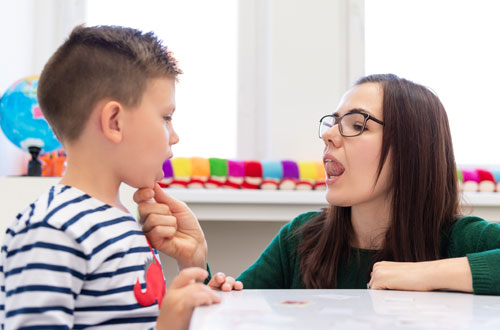Language Disorders
Quite often parents and teachers will report concerns about a “speech delay”. However, during assessment it may become clear that the child has a language disorder. Are they not the same thing? No. Speech and language are very different.
Language is made up of socially shared rules that include the following:
- What words mean (e.g., “star” can refer to a bright object in the night sky or a celebrity)
- How to make new words (e.g., friend, friendly, unfriendly)
- How to put words together (e.g., “Peg walked to the new store” rather than “Peg walk store new”)
- What word combinations are best in what situations (“Would you mind moving your foot?” could quickly change to “Get off my foot, please!” if the first request did not produce results)

Speech consists of the following:
- Articulation
How speech sounds are made (e.g., children must learn how to produce the “r” sound in order to say “rabbit” instead of “wabbit”). - Voice
Use of the vocal folds and breathing to produce sound (e.g., the voice can be abused from overuse or misuse and can lead to hoarseness or loss of voice). - Fluency
The rhythm of speech (e.g., hesitations or stuttering can affect fluency).
Developmental Language Disorder (DLD) is the new term to replace Specific Language Impairment (SLI). Developmental Language Disorder is diagnosed when children fail to acquire their own language for no obvious reason. This can happen in children who speak one or more languages. This results in children who have difficulty understanding what people say to them, and struggle to express their ideas and feelings.
It is clear that DLD commonly occurs with ADHD and dyslexia. However, there has been much debate about overlap with Autism Spectrum Disorder (ASD). Many children with DLD do not have the social problems characteristic of Autism. There is, however, a marked difference in the help available for children with a diagnosis of Autism vs DLD. This difference persists into adulthood, where both dyslexia and autism are recognised disabilities, whereas there is very little awareness of DLD. Children with Autism Spectrum Disorder may be diagnosed with Language Disorder associated with their diagnosis of Autism.
Early identification and intervention is key for children with DLD. Speech and language therapists and specialist teachers can help those with DLD to develop skills and strategies, and to understand their difficulties and their strengths.
If you are concerned about your child’s ability to understand and use verbal and written language, please do contact us to make an appointment for an assessment. A speech and language therapy assessment can identify a child’s area of strengths and areas to develop allowing specific, tailor made therapy to be put in place.